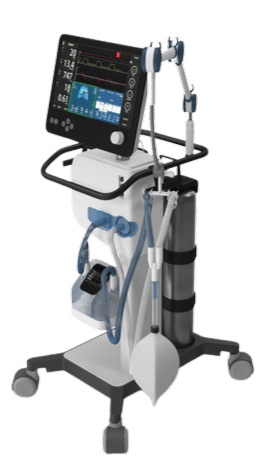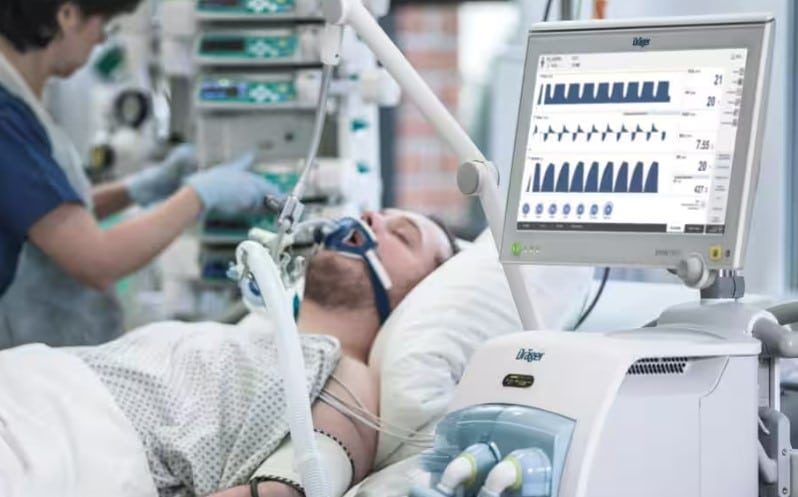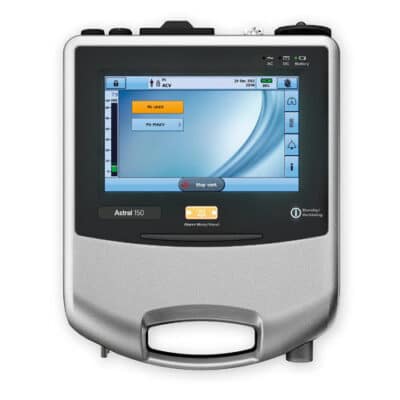Respiratory Zone
Affordable Ventilators at Your Doorstep in Lahore, Karachi & Islamabad

Looking for Affordable Yet Quality Oxygen Concentrators? Contact: 03192004884
Respiratory Zone’s Best Selling Ventilators
What is a Ventilator?
A ventilator is a life-saving medical device designed to assist or take over the breathing process for patients who are unable to breathe adequately on their own. Its primary purpose is to ensure that patients with respiratory failure or difficulty breathing receive sufficient oxygen to their lungs and that carbon dioxide is appropriately removed from their bodies. This is crucial in medical settings for patients who, due to various conditions, cannot maintain the necessary levels of oxygenation and gas exchange to support bodily functions. Ventilators Lahore Karachi Islamabad, Pakistan.
Ventilators play a critical role in the care of patients with severe respiratory conditions, such as acute respiratory distress syndrome (ARDS), chronic obstructive pulmonary disease (COPD), or those undergoing major surgeries that affect respiratory function. They are also pivotal in the treatment of patients affected by respiratory illnesses like pneumonia and, as seen recently, those suffering from severe cases of COVID-19.

There are two main types of ventilators: invasive and non-invasive. Invasive ventilators are used for patients who are critically ill and require endotracheal intubation or a tracheostomy, where a tube is inserted directly into the patient’s windpipe to deliver oxygen directly to the lungs. Non-invasive ventilation (NIV) is used for patients who need respiratory support but do not require such an invasive approach. NIV methods include devices like CPAP (Continuous Positive Airway Pressure) and BiPAP (Bilevel Positive Airway Pressure) machines, which provide pressurized air through a mask to assist the patient’s breathing without the need for intubation.
Ventilators are used in various settings, primarily in Intensive Care Units (ICUs), where patients with the most severe respiratory needs are treated. However, with advancements in technology, ventilators are also increasingly used in long-term care facilities and for home care, allowing patients to receive necessary respiratory support outside the hospital setting. This has been especially beneficial for patients with chronic respiratory conditions, enabling them to lead more normal lives.
The basic operational principles of a ventilator involve adjusting various parameters such as the volume of air delivered (tidal volume), the rate at which air is delivered (respiratory rate), the concentration of oxygen in the air mixture (FiO2), and the pressure applied during inhalation and exhalation. The specific settings are meticulously adjusted by healthcare professionals based on the patient’s needs to ensure optimal support while minimizing potential harm, such as lung injury from overdistension.
How Do Ventilators Work?
Ventilators are life-saving machines designed to assist or replace the breathing process when a person is unable to breathe adequately on their own. They are crucial in intensive care units (ICUs) for patients with severe respiratory conditions. Understanding how these machines work involves exploring the simulation of natural breathing processes, the mechanics behind the delivery of air to the lungs, and the critical role of personalized ventilation settings.
Mimicking Natural Breathing
At its core, a ventilator’s primary function is to replicate the natural process of breathing. Breathing naturally involves inhaling oxygen-rich air into the lungs and exhaling carbon dioxide-laden air out. Ventilators achieve this by:
Inhaling Phase (Inspiration): The machine pushes air (or a mixture of gases) into the lungs through a tube inserted into the patient’s airway. This phase imitates the muscle contraction of the diaphragm and chest muscles that expand the chest cavity and lower the pressure inside the lungs, causing air to flow in.
Exhaling Phase (Expiration): Unlike the active process of inhalation, exhalation on a ventilator is mostly passive. The machine stops delivering air, allowing the lungs and chest to return to their resting state, pushing the air out due to the elastic recoil properties of the chest and lungs.
Mechanics of Air Delivery
Ventilators can deliver air to the lungs in several ways, primarily focusing on two aspects: pressure control and volume control.
Pressure Control: The ventilator delivers air until a pre-set pressure is reached in the airway. This mode ensures a consistent pressure regardless of changes in lung compliance but can result in variable tidal volumes (the amount of air moved in or out during a single breath).
Volume Control: Here, the machine delivers a pre-set volume of air with each breath. This ensures that the patient receives a consistent amount of air, but the pressure may vary based on the resistance and compliance of the patient’s lungs.
The Importance of Ventilation Settings
Tailoring ventilation settings to the individual needs of patients is crucial for effective ventilation without causing harm. Key settings include:
- Tidal Volume: The amount of air delivered with each breath. Setting this too high can lead to lung injury, while setting it too low may not adequately remove carbon dioxide.
- Respiratory Rate: The number of breaths delivered per minute. This needs to match the patient’s metabolic needs.
- Oxygen Concentration: Adjusting the percentage of oxygen in the delivered air is vital, especially for patients with specific needs for higher or lower oxygen levels.
- Positive End-Expiratory Pressure (PEEP): This is a low pressure applied at the end of the exhalation phase to keep the alveoli open, improving oxygenation and facilitating gas exchange.
Visual Aids for Clarity
Since I can’t provide actual diagrams or videos, it’s recommended to consult medical textbooks or trusted online medical resources for visual aids. Diagrams typically illustrate the ventilator circuit, the interaction between the machine and the lungs, and how different settings affect the lungs. Videos often offer step-by-step explanations of the ventilator’s operation, including how adjustments to the settings impact the patient’s breathing process.
Understanding the operation of ventilators is critical for healthcare professionals working in critical care settings. These devices are complex, and their optimal use requires a deep understanding of both the machinery and the unique physiology of each patient.
Looking for Affordable Respiratory Equipment?

Ventilators on Rent/Sale in Karachi
Karachi, the bustling metropolis and economic hub of Pakistan, is home to a diverse population with significant healthcare needs. Among the critical medical equipment in demand, ventilators stand out, especially in light of the global health challenges posed by respiratory illnesses. Ventilators are life-saving devices used in hospitals and homes to assist patients who have difficulty breathing. In Karachi, finding a ventilator for rent or sale requires navigating a complex market of medical equipment suppliers and healthcare services. This exploration highlights the key players, pricing trends, available models, and regulatory considerations in Karachi’s ventilator market.
Several reputable medical equipment suppliers offer ventilators for rent and sale in Karachi. These include:
- MediRent Services: Specializing in a wide range of medical equipment rentals, including ventilators, MediRent Services offers solutions tailored to both home care and hospital settings.
- Healthcare Solutions: Known for its comprehensive portfolio of medical supplies, Healthcare Solutions provides both new and refurbished ventilators, catering to various budgetary needs.
- Karachi Medical Supplies: With a focus on high-quality medical devices, Karachi Medical Supplies is a go-to for healthcare facilities and individuals seeking reliable ventilator options.
Significance in Karachi’s Healthcare Infrastructure
Access to ventilators in Karachi is of paramount importance. The city’s large population and the varying quality of healthcare facilities make it essential to have a robust supply of these critical devices. Ventilators play a vital role in emergency rooms, ICUs, and home care settings, saving lives during respiratory crises. The COVID-19 pandemic underscored the need for adequate ventilator availability, pushing healthcare providers and suppliers to increase their stocks and ensure broader access.
Looking for Affordable Respiratory Equipment?

Ventilators on Rent/Sale in Lahore
In Lahore, the need for ventilators in healthcare settings has been underscored by the increasing incidence of respiratory ailments, emergencies, and the global challenges posed by pandemics. Ventilators, being critical in providing life-saving support to patients with severe respiratory problems, have seen a surge in demand. Lahore, being a major urban center in Pakistan, has several reputable suppliers and rental services that cater to this vital need, ensuring that both individuals and healthcare facilities can access these essential medical devices with ease.
Ease of Access, Cost, and Quality
The availability of ventilators for rent or sale in Lahore varies significantly in terms of cost, quality, and access. Several medical equipment suppliers offer a range of ventilators, from basic models suitable for home care to advanced units designed for intensive care units (ICUs). The cost of renting or purchasing a ventilator can vary based on the model, features, and rental duration. However, most suppliers provide flexible terms to accommodate the financial constraints of different customers. Quality assurance is a top priority, with suppliers often offering devices from reputable manufacturers known for their reliability and effectiveness in clinical settings.
Recognizing the importance of ventilator availability, several community support programs and government initiatives in Lahore aim to improve access to these life-saving devices. For instance, government hospitals and health facilities often provide ventilators at subsidized rates or free of charge to underprivileged patients. Moreover, non-profit organizations and philanthropic individuals frequently donate ventilators to hospitals and offer rental subsidies to those in need.
Looking for Affordable Respiratory Equipment?

Ventilators on Rent/Sale in Islamabad
Islamabad, the capital city of Pakistan, stands at the forefront of healthcare advancements, with its hospitals and clinics equipped with state-of-the-art medical facilities. Among the essential medical equipment that supports life-saving procedures are ventilators. These devices are crucial for patients who require assistance in breathing due to various medical conditions.
In Islamabad, avenues for renting or purchasing ventilators are numerous, reflecting the city’s commitment to providing advanced healthcare services. This guide explores the best practices for selecting a ventilator, including considerations of technology, compatibility, and supplier reliability, and discusses the impact of these practices on patient care quality in Islamabad’s healthcare facilities. Additionally, it highlights the role of government regulations and support in ensuring the availability of these critical devices.
Selecting a Ventilator: Best Practices
When deciding to rent or purchase a ventilator in Islamabad, it’s essential to consider several key factors to ensure the device meets the highest standards of medical care:
- Technology: Modern ventilators are equipped with advanced technologies that provide a range of ventilation modes and settings to cater to different patient needs. Look for devices that offer flexibility, ease of use, and precise control.
- Compatibility: Ensure that the ventilator is compatible with other medical equipment in the healthcare facility. Compatibility enhances the efficiency of patient care management and reduces the risk of technical issues.
- Supplier Reliability: Choose suppliers with a proven track record of providing high-quality medical equipment. Reliable suppliers offer after-sales support, including maintenance and training on how to use the ventilator effectively.

